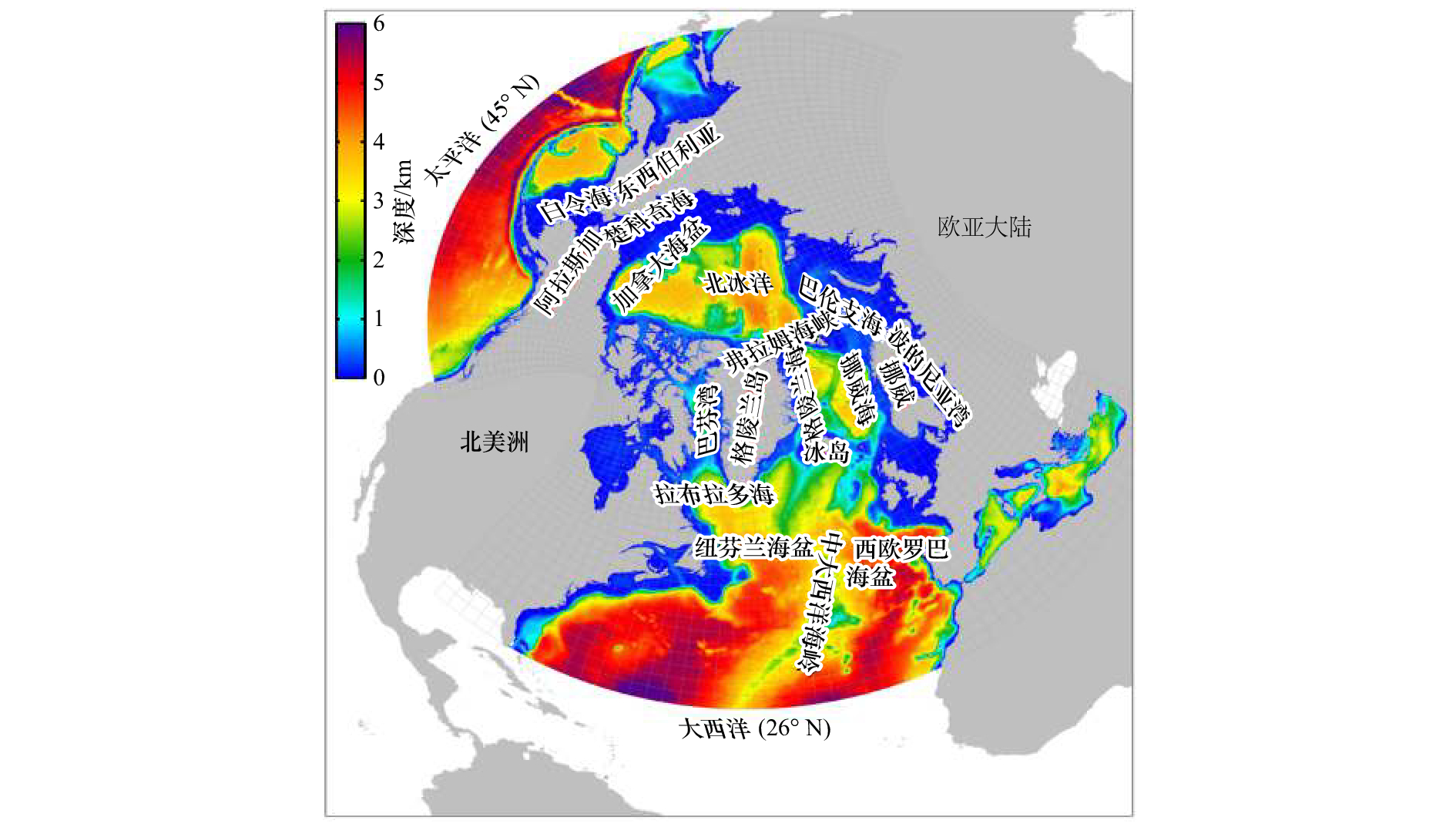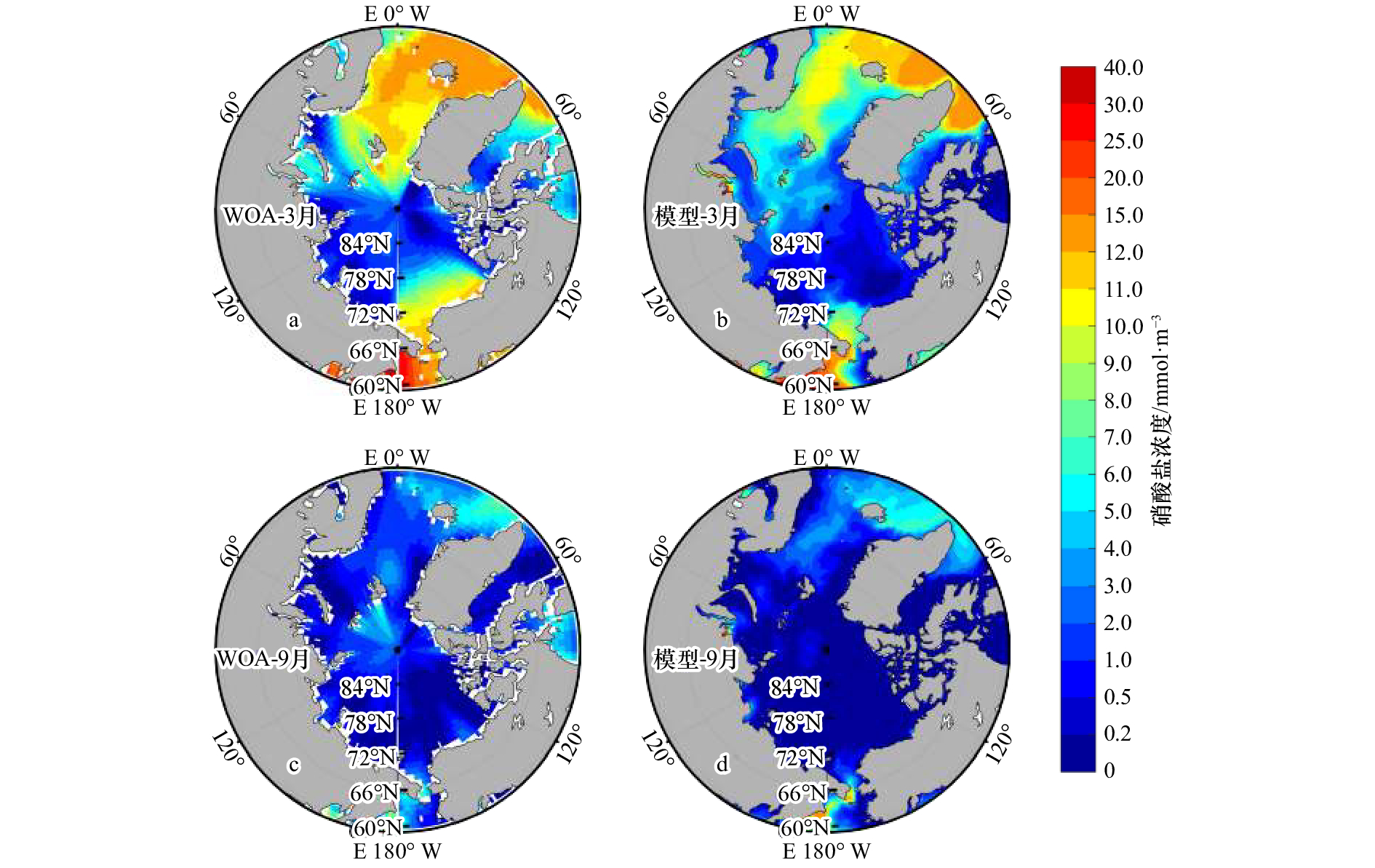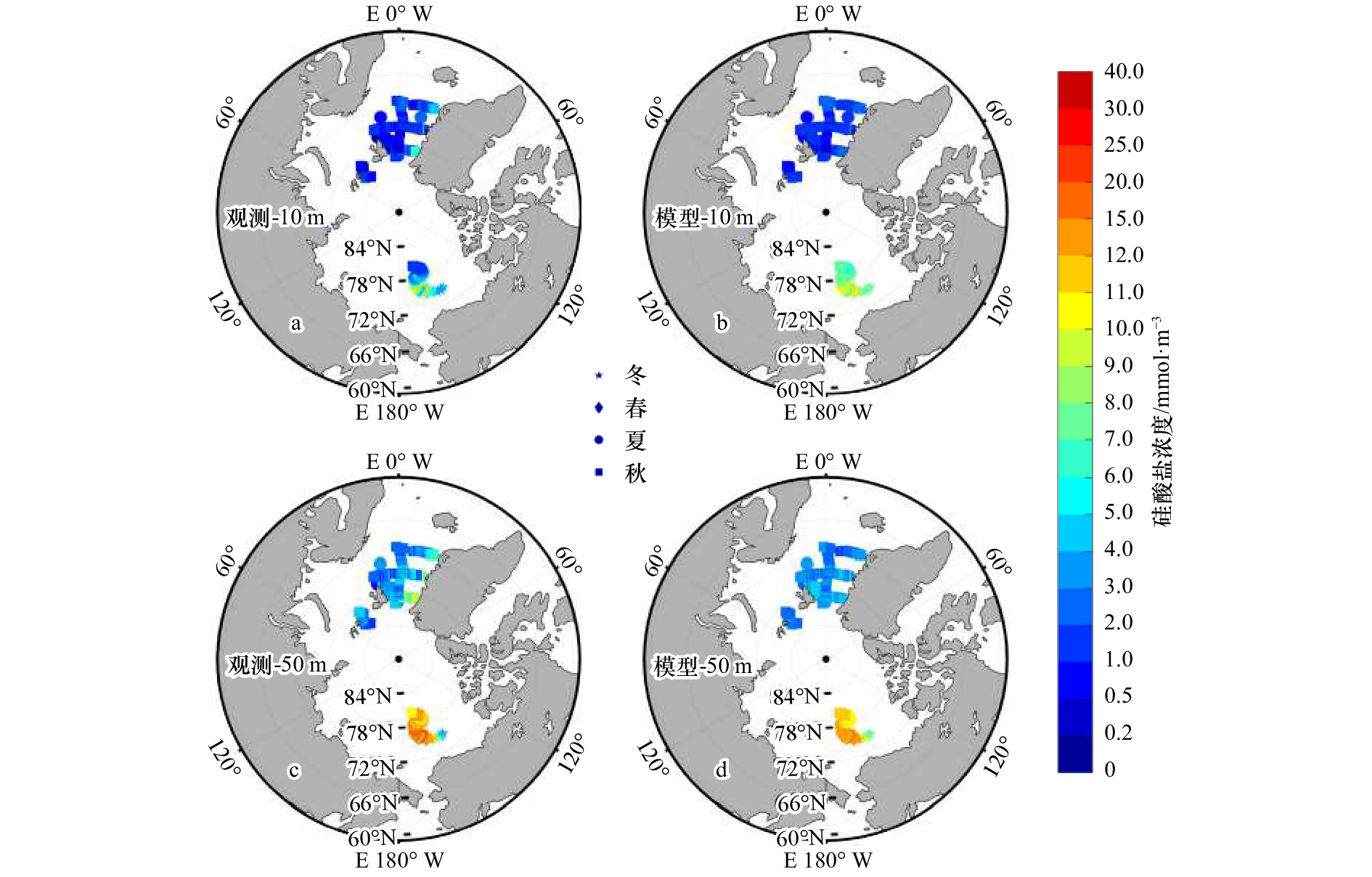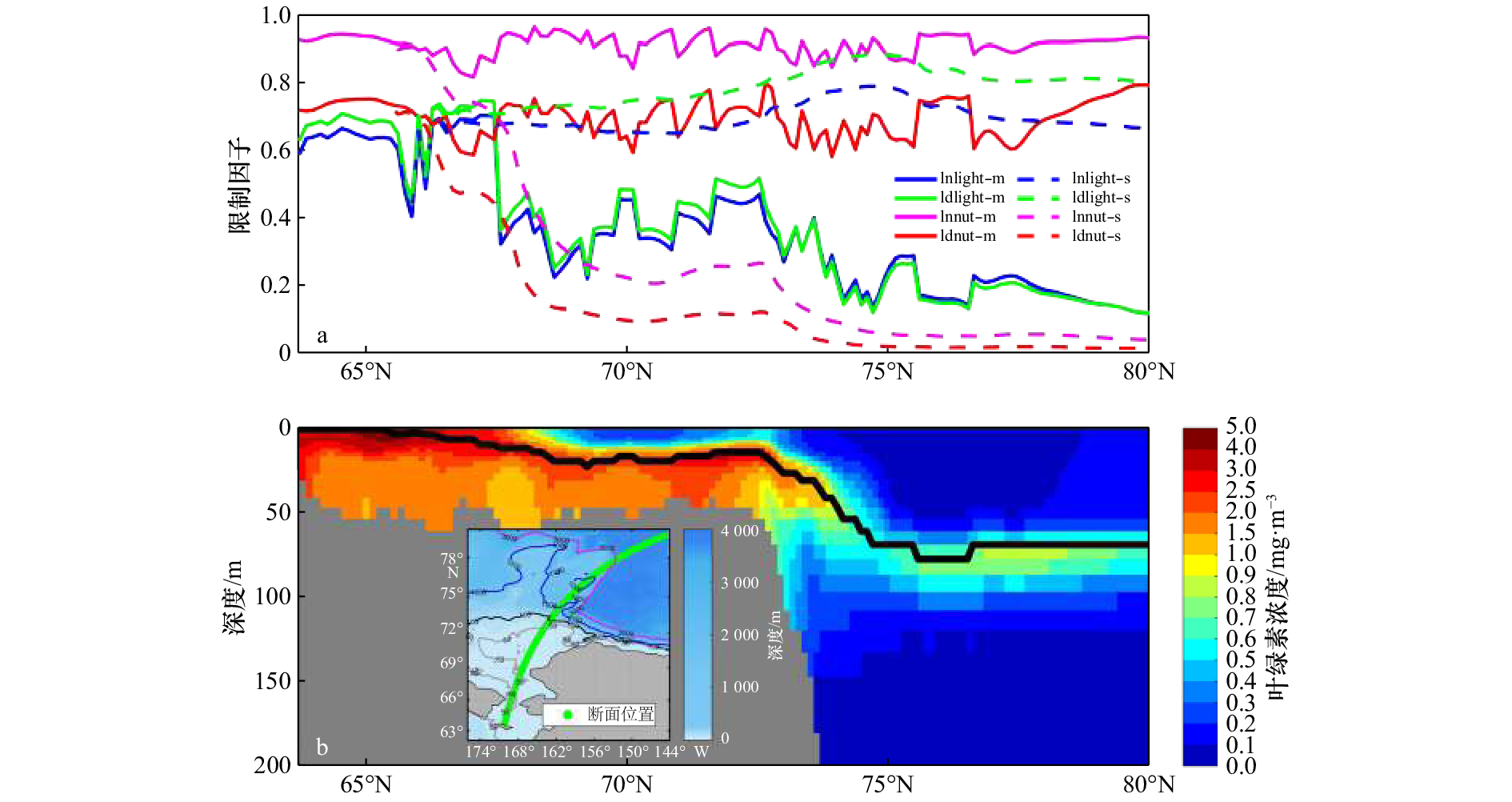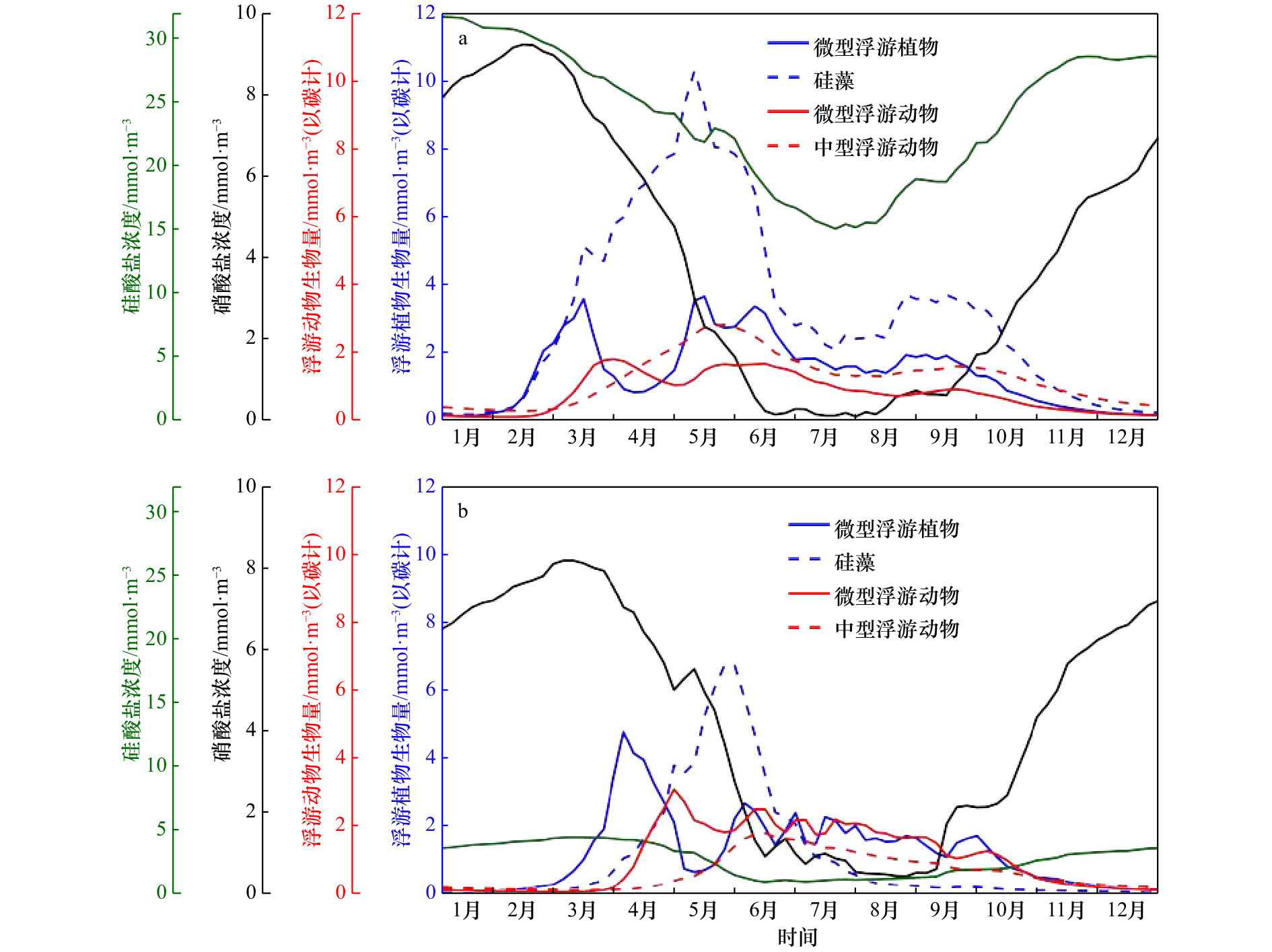Simulation of spatial distribution and seasonal variation of plankton in the Arctic Ocean
-
摘要: 低营养级浮游生物生态动力过程对环境变化的响应非常敏感。随着全球气候变化加剧,北冰洋正在经历快速的环境变化。厘清北冰洋低营养级浮游生物季节分布与变化特征是探究北冰洋生态系统对环境快速变化响应的前提,也是评估北极海区固碳能力的重要依据。基于此,本文构建了海洋–海冰–生物地球化学循环模型,并对北冰洋叶绿素浓度以及浮游生物结构的时空变化特征进行了模拟,结果表明:(1)北冰洋表层叶绿素浓度的峰值主要出现在5月,且太平洋一侧叶绿素浓度高于大西洋一侧;随着海水层化,表层受营养盐限制的海区呈现次表层叶绿素浓度最大值现象,且由陆架向海盆,次表层叶绿素浓度最大值层逐渐加深;9月,叶绿素浓度高值重回水体上层,太平洋一侧海区表层叶绿素浓度呈现较为明显的次峰值。(2)由于太平洋和大西洋入流营养盐浓度及结构的不同,北冰洋表层浮游生物群落结构存在明显空间差异。太平洋一侧,硅藻和中型浮游动物占优,硅藻在5月和9月出现生物量峰值,微型浮游植物在3月、5月和6月维持相对较高生物量;而大西洋一侧,在早春-春末夏初-夏秋经历了微型浮游植物-硅藻-微型浮游植物的演替,总体而言,微型浮游植物和微型浮游动物占优。此外,两侧海区浮游动物浓度峰值相较浮游植物滞后约半月。
-
关键词:
- 浮游植物 /
- 营养盐 /
- 海洋–海冰–生物地球化学循环模型 /
- 北冰洋
Abstract: Eco-dynamics of marine plankton are remarkably sensitive to changes in their environments. The Arctic Ocean is undergoing rapid environmental changes as the global climate change intensifies. Understanding the seasonal distribution and variation of low-trophic plankton is a prerequisite for exploring the response of ecosystem to changing environment in the Arctic Ocean, and is also an important basis for assessing the carbon sequestration capacity of the Arctic Ocean. Based on above, a coupled ocean-sea ice-biogeochemical cycling model was developed and applied to evaluate the temporal-spatial variations of chlorophyll a concentration and planktonic structures in the Arctic Ocean. The results suggested that: (1) surface chlorophyll a concentration mainly peaks in May, with the higher values on the Pacific side than the Atlantic; since stratification occurs, subsurface chlorophyll a maximums are found in areas having limited nutrients at surface, and the depth of subsurface chlorophyll a maximums gradually deepens from the shelf towards the basin; in September, the high chlorophyll a concentration returns to the upper layer from the subsurface, presenting a sub-peak of surface chlorophyll a concentration on the Pacific side. (2) Substantial regional differences in surface plankton communities exist in the Arctic Ocean due to the influences of the Pacific and Atlantic inflows with variations in nutrients concentrations and structures. Diatom and mesozooplankton are dominant species on the Pacific side where diatom biomass exhibits two peaks in May and September, meanwhile nanophytoplankton maintains relatively high biomass in March, May and June. Atlantic side experiences a seasonal succession from nanophytoplankton to diatom then to nanophytoplankton corresponding to early spring, late spring-early summer, and summer-autumn, respectively. Over the entire growth season, nanophytoplankton and microzooplankton dominate on the Atlantic side. Generally, the peak biomass of zooplankton has a lag for half a month to the peak of phytoplankton biomass in the Arctic Ocean. -
图 1 生态模型概念示意图
DIC:溶解无机碳;TA:总碱度;pCO2:海面二氧化碳分压;pH:海水酸碱度:sPOC:小型颗粒有机碳;bPOC:大型颗粒有机碳;NIT:硝酸盐; AMM:铵盐;SIL:硅酸盐;PHO:磷酸盐;DOM:溶解有机物;DO:溶解氧;CaCO3:碳酸钙
Fig. 1 Schematic diagram of ecosystem model
DIC: dissolved inorganic carbon; TA: total alkalinity; pCO2: partial pressure of carbon dioxide; pH: acidity or alkalinity of seawater; sPOC: small particulate organic carbon; bPOC: big particulate organic carbon; NIT: nitrate; AMM: ammonium; SIL: silicate; PHO: phosphate; DOM: dissolved organic matter; DO: dissolved oxygen; CaCO3: calcium carbonate
图 9 7月白令海峡–楚科奇海–加拿大盆地断面表层及叶绿素浓度最大值处浮游植物生长限制因子(a)及该断面叶绿素浓度分布(b)
图a的图例中lnlight,ldlight,lnnut,ldnut分别为微型浮游植物光限制因子,硅藻光限制因子,微型浮游植物营养盐限制因子,硅藻营养盐限制因 子;-s代表表层;-m为叶绿素浓度最大值处。图b中黑线表示叶绿素浓度最大值位置,图b中子图为断面位置
Fig. 9 Phytoplankton growth limiting factors at surface and depth of chlorophyll a maximum (a) and chlorophyll a concentration at the section located adjacent Bering Strait-Chukchi Sea-Canada Basin (green line shown in Fig. b) in July (b)
The lnlight,ldlight,lnnut,ldnut in Fig. a denote the limiting effects of light and nutrients on nanophytoplankton and diatom, respectively.; -s: at surface layer; –m: for the layer of chlorophyll a maximum; black line in Fig. b shows the position of chlorophyll a maximum; subgraph in Fig.b shows the position of section
表 1 北极海区部分研究生态系统的模型
Tab. 1 Part studying of ecosystem model about Arctic Ocean
研究海区 模式特点 主要状态变量 主要研究问题 参考文献 巴伦支海及其邻近海域 1维和3维,水平分辨率20 km,垂向12层 1维:2种Phyto-p,3种营养盐(2种N,1种Si),2种Zoo-p,1种G;3维:2种Phyto-p,1种营养盐(N) 年均PP 文献[20] 3维,水平分辨率20 km,垂向25层 2种Phyto-p,3种营养盐(2种N,1种Si),4种Zoo-p,2种D,1种B,1种DOC 气候变化对PP的影响,酸化,碳通量 文献[21-22, 24] 白令海、楚科奇海及其邻近海域 2维,垂向39层 2种营养盐(2种N),1种Chl-a,1种B,3种DOC Chl-a和PP空间变化 文献[25] 3维,水平分辨率(1/12)°,垂向45层(含1 cm沉积层) 4种营养盐(2种N,2种Si),2种G,2种DOC,2种DIC,4种D,1种B 碳汇,PP季节变化,海洋食物网 文献[26-27] 3维,水平分辨率5~10 km,垂向24层,PhEcoM模型 3种营养盐(N,P,Si),1种Phyto-p,1种Zoo-p,1种D PP分布与季节变化 文献[38-39] 波弗特海、加拿大北极群岛海域 1维,垂向22层 3种营养盐(N,P,Si),1种Phyto-p,1种Zoo-p ,1种IA,3种D IA和PP季节变化 文献[29-30] 1维,垂向100层 3种营养盐(2种N,1种Si),2种Phyto-p,2种Zoo-p ,1种IA,2种D,1种BSi IA和PP季节变化 文献[28] 北冰洋海域 3维,水平分辨率4~10 km,垂向30层,BIOMAS模型 3种营养盐(2种N,1种Si),2种Phyto-p,3种Zoo-p,1种DON,2种D,1种IA 海冰和营养盐对冰下PP的影响 文献[7, 35] 3维,水平分辨率15 km,
50 km,垂向40层,NORWECOM模型3种营养盐(N,P,Si),2种Phyto-p,3种Zoo-p,1种DON,2种D,1种DO,1种BSi 生态系统的变化 文献[31] 3维,水平分辨率(1/4)°,垂向75层,MEDUSA模型 3种营养盐(N,Si,Fe),2种Phyto-p,2种Zoo-p,2种Chl-a,2种D,1种DIC,1种TA,1种DO,1种sPOC 环境改变对生态系统的影响 文献[14, 32-33] 3维,水平分辨率30~50 km,垂向40层,LANL-UAF模型 5种营养盐(2种N,1种P,1种Si,1种Fe),3种Phyto-p,1种Zoo-p,1种IA,3种Chl-a,2种D,1种DIC,1种TA,1种DO,1种DOC,1种DON,1种DOP,1种DOFe 冰下PP变化,IA 文献[36-37, 41] 3维,水平分辨率(1/4)°,垂向75层,PISCES模型 5种营养盐(2种N,1种P,1种Si,1种Fe),2种Phyto-p,2种Zoo-p,2种Chl-a,1种DIC,1种TA,1种DO,1种DOC,1种sPOC,1种bPOC PP变化 文献[40] 注:N、P、Si、Fe分别代表含氮、磷、硅、铁的无机营养盐;Phyto-p指浮游植物;Zoo-p指浮游动物;IA指冰藻;B、G、D分别代表细菌、游泳动物、有机碎屑;Chl-a指叶绿素;DIC指溶解无机碳;DOC指溶解有机碳;sPOC指小型颗粒有机碳;bPOC指大型颗粒有机碳;DON指溶解有机氮;DOP指溶解有机磷;DOFe指溶解有机铁;DO指溶解氧;TA指总碱度;BSi指生物硅;PP指初级生产。 -
[1] Woodgate R A. Increases in the Pacific inflow to the Arctic from 1990 to 2015, and insights into seasonal trends and driving mechanisms from year-round Bering Strait mooring data[J]. Progress in Oceanography, 2018, 160: 124−154. doi: 10.1016/j.pocean.2017.12.007 [2] Wood K R, Bond N A, Danielson S L, et al. A decade of environmental change in the Pacific Arctic region[J]. Progress in Oceanography, 2015, 136: 12−31. doi: 10.1016/j.pocean.2015.05.005 [3] Stroeve J C, Kattsov V, Barrett A, et al. Trends in Arctic sea ice extent from CMIP5, CMIP3 and observations[J]. Geophysical Research Letters, 2012, 39(16): L16502. [4] 曹勇, 赵进平. 2011-2014年中国北极物理海洋学的研究进展[J]. 海洋学报, 2015, 37(11): 1−10. doi: 10.3969/j.issn.0253-4193.2015.11.001Cao Yong, Zhao Jinping. Progress in Arctic physical oceanography in China during 2011-2014[J]. Haiyang Xuebao, 2015, 37(11): 1−10. doi: 10.3969/j.issn.0253-4193.2015.11.001 [5] Anderson L G, Macdonald R W. Observing the Arctic Ocean carbon cycle in a changing environment[J]. Polar Research, 2015, 34(1): 26891. doi: 10.3402/polar.v34.26891 [6] 陈立奇, 祁第, 高众勇, 等. 快速融冰背景下北冰洋夏季表层海水CO2分压的变异假设[J]. 科学通报, 2016, 61(21): 2419−2425.Chen Liqi, Qi Di, Gao Zhongyong, et al. A hypothesis on variability of surface water pCO2 under the rapid sea-ice retreat during summer in the Arctic Ocean[J]. Chinese Science Bulletin, 2016, 61(21): 2419−2425. [7] Zhang Jinlun, Ashjian C, Campbell R, et al. The influence of sea ice and snow cover and nutrient availability on the formation of massive under-ice phytoplankton blooms in the Chukchi Sea[J]. Deep-Sea Research Part II: Topical Studies in Oceanography, 2015, 118: 122−135. doi: 10.1016/j.dsr2.2015.02.008 [8] Pabi S, van Dijken G L, Arrigo K R. Primary production in the Arctic Ocean, 1998-2006[J]. Journal of Geophysical Research, 2008, 113(C8): C08005. [9] 高众勇, 陈立奇, Cai Weijun, et al. 全球变化中的北极碳汇: 现状与未来[J]. 地球科学进展, 2007, 22(8): 857−865. doi: 10.3321/j.issn:1001-8166.2007.08.012Gao Zhongyong, Chen Liqi, Cai Weijun, et al. Arctic carbon sink in global change: present and future[J]. Advances in Earth Science, 2007, 22(8): 857−865. doi: 10.3321/j.issn:1001-8166.2007.08.012 [10] Zhuang Yanpei, Jin Haiyan, Gu Fan, et al. Composition of algal pigments in surface freshen layer after ice melt in the central Arctic[J]. Acta Oceanologica Sinica, 2017, 36(8): 122−130. doi: 10.1007/s13131-017-1024-0 [11] Arrigo K R, van Dijken G L. Continued increases in Arctic Ocean primary production[J]. Progress in Oceanography, 2015, 136: 60−70. doi: 10.1016/j.pocean.2015.05.002 [12] Brown Z W, Arrigo K R. Contrasting trends in sea ice and primary production in the Bering Sea and Arctic Ocean[J]. ICES Journal of Marine Science, 2012, 69(7): 1180−1193. doi: 10.1093/icesjms/fss113 [13] 李宏亮, 陈建芳, 高生泉, 等. 西北冰洋中太平洋入流水营养盐的变化特征[J]. 海洋学报, 2011, 33(2): 85−95.Li Hongliang, Chen Jianfang, Gao Shengquan, et al. Nutrients variation of the Pacific inflow in the western Arctic Ocean[J]. Haiyang Xuebao, 2011, 33(2): 85−95. [14] Popova E E, Yool A, Coward A C, et al. Control of primary production in the Arctic by nutrients and light: insights from a high resolution ocean general circulation model[J]. Biogeosciences, 2010, 7(11): 3569−3591. doi: 10.5194/bg-7-3569-2010 [15] 高生泉, 陈建芳, 李宏亮, 等. 2008年夏季白令海营养盐的分布及其结构状况[J]. 海洋学报, 2011, 33(2): 157−165.Gao Shengquan, Chen Jianfang, Li Hongliang, et al. The distribution and structural conditions of nutrients in the Bering Sea in the summer of 2008[J]. Haiyang Xuebao, 2011, 33(2): 157−165. [16] Stabeno P J, Danielson S L, Kachel D G, et al. Currents and transport on the eastern Bering Sea shelf: An integration of over 20 years of data[J]. Deep-Sea Research Part II: Topical Studies in Oceanography, 2016, 134: 13−29. doi: 10.1016/j.dsr2.2016.05.010 [17] Arrigo K R, Perovich D K, Pickart R S, et al. Phytoplankton blooms beneath the sea ice in the Chukchi Sea[J]. Deep-Sea Research Part II: Topical Studies in Oceanography, 2014, 105: 1−16. doi: 10.1016/j.dsr2.2014.03.018 [18] Arrigo K R, Perovich D K, Pickart R S, et al. Massive phytoplankton blooms under Arctic sea ice[J]. Science, 2012, 336(6087): 1408. doi: 10.1126/science.1215065 [19] McLaughlin F A, Carmack E C. Deepening of the nutricline and chlorophyll maximum in the Canada Basin interior, 2003–2009[J]. Geophysical Research Letters, 2010, 37(24): L24602. [20] Slagstad D, Støle-Hansen K. Dynamics of plankton growth in the Barents Sea: model studies[J]. Polar Research, 1991, 10(1): 173−186. doi: 10.1111/j.1751-8369.1991.tb00643.x [21] Wassmann P, Slagstad D, Ellingsen I. Primary production and climatic variability in the European sector of the Arctic Ocean prior to 2007: preliminary results[J]. Polar Biology, 2010, 33(12): 1641−1650. doi: 10.1007/s00300-010-0839-3 [22] Ellingsen I H, Dalpadado P, Slagstad D, et al. Impact of climatic change on the biological production in the Barents Sea[J]. Climatic Change, 2008, 87(1/2): 155−175. [23] Slagstad D, McClimans T A. Modeling the ecosystem dynamics of the Barents Sea including the marginal ice zone: Ⅰ. physical and chemical oceanography[J]. Journal of Marine Systems, 2005, 58(1/2): 1−18. [24] Wassmann P, Slagstad D, Riser C W, et al. Modelling the ecosystem dynamics of the Barents Sea including the marginal ice zone: Ⅱ. carbon flux and interannual variability[J]. Journal of Marine Systems, 2006, 59(1/2): 1−24. [25] Shuert P G, Walsh J J. A coupled physical-biological model of the Bering-Chukchi seas[J]. Continental Shelf Research, 1993, 13(5/6): 543−573. [26] Walsh J J, Dieterle D A, Maslowski W, et al. A numerical model of seasonal primary production within the Chukchi/Beaufort Seas[J]. Deep-Sea Research Part Ⅱ: Topical Studies in Oceanography, 2005, 52(24/26): 3541−3576. [27] Walsh J J, Dieterle D A, Maslowski W, et al. Decadal shifts in biophysical forcing of Arctic marine food webs: numerical consequences[J]. Journal of Geophysical Research, 2004, 109(C5): C05031. [28] Mortenson E, Hayashida H, Steiner N, et al. A model-based analysis of physical and biological controls on ice algal and pelagic primary production in resolute passage[J]. Elementa: Science of the Anthropocene, 2017, 5: 39. [29] Lavoie D, Macdonald R W, Denman K L. Primary productivity and export fluxes on the Canadian shelf of the Beaufort Sea: a modelling study[J]. Journal of Marine Systems, 2009, 75(1/2): 17−32. [30] Lavoie D, Denman K, Michel C. Modeling ice algal growth and decline in a seasonally ice-covered region of the Arctic (Resolute Passage, Canadian Archipelago)[J]. Journal of Geophysical Research, 2005, 110(C11): C11009. doi: 10.1029/2005JC002922 [31] Samuelsen A, Hansen C, Wehde H. Tuning and assessment of the HYCOM-NORWECOM V2[J]. Geoscientific Model Development, 2015, 8(7): 2187−2202. doi: 10.5194/gmd-8-2187-2015 [32] Yool A, Popova E E, Anderson T R. MEDUSA-2.0: an intermediate complexity biogeochemical model of the marine carbon cycle for climate change and ocean acidification studies[J]. Geoscientific Model Development, 2013, 6(5): 1767−1811. doi: 10.5194/gmd-6-1767-2013 [33] Yool A, Popova E E, Anderson T R. Medusa-1.0: a new intermediate complexity plankton ecosystem model for the global domain[J]. Geoscientific Model Development, 2011, 4(2): 381−417. doi: 10.5194/gmd-4-381-2011 [34] Zhang Jinlun, Ashjian C, Campbell R, et al. The great 2012 Arctic Ocean summer cyclone enhanced biological productivity on the shelves[J]. Journal of Geophysical Research, 2014, 119(1): 297−312. [35] Zhang Jinlun, Spitz Y H, Steele M, et al. Modeling the impact of declining sea ice on the Arctic marine planktonic ecosystem[J]. Journal of Geophysical Research, 2010, 115(C10): C10015. doi: 10.1029/2009JC005387 [36] Jin Meibing, Deal C, Lee S H, et al. Investigation of Arctic sea ice and ocean primary production for the period 1992-2007 using a 3-D global ice-ocean ecosystem model[J]. Deep-Sea Research Part II: Topical Studies in Oceanography, 2012, 81-84: 28−35. doi: 10.1016/j.dsr2.2011.06.003 [37] Jin Meibing, Deal C, Wang Jia. A coupled ice-ocean ecosystem model for 1-D and 3-D applications in the Bering and Chukchi Seas[J]. Chinese Journal of Polar Science, 2008, 19(2): 218−229. [38] Hu Haoguo, Wang Jia, Liu Hui, et al. Simulation of phytoplankton distribution and variation in the Bering-Chukchi Sea using a 3-D physical-biological model[J]. Journal of Geophysical Research, 2016, 121(6): 4041−4055. [39] Wang Jia, Hu Haoguo, Goes J, et al. A modeling study of seasonal variations of sea ice and plankton in the Bering and Chukchi Seas during 2007–2008[J]. Journal of Geophysical Research, 2013, 118(3): 1520−1533. [40] Aumont O, Ethé C, Tagliabue A, et al. PISCES-v2: an ocean biogeochemical model for carbon and ecosystem studies[J]. Geoscientific Model Development, 2015, 8(8): 2465−2513. doi: 10.5194/gmd-8-2465-2015 [41] Popova E E, Yool A, Coward A C, et al. What controls primary production in the Arctic Ocean? Results from an intercomparison of five general circulation models with biogeochemistry[J]. Journal of Geophysical Research, 2012, 117(C8): C00D12. [42] Jin Meibing, Popova E E, Zhang Jinlun, et al. Ecosystem model intercomparison of under-ice and total primary production in the Arctic Ocean[J]. Journal of Geophysical Research, 2016, 121(1): 934−948. [43] Steiner N S, Sou T, Deal C, et al. The future of the subsurface chlorophyll-a maximum in the Canada Basin—A model intercomparison[J]. Journal of Geophysical Research, 2016, 121(1): 387−409. [44] Yool A, Popova E E, Coward A C. Future change in ocean productivity: is the Arctic the new Atlantic?[J]. Journal of Geophysical Research, 2015, 120(12): 7771−7790. [45] Wang S, Bailey D, Lindsay K, et al. Impact of sea ice on the marine iron cycle and phytoplankton productivity[J]. Biogeosciences, 2014, 11(17): 4713−4731. doi: 10.5194/bg-11-4713-2014 [46] Moore J K, Doney S C, Glover D M, et al. Iron cycling and nutrient-limitation patterns in surface waters of the world ocean[J]. Deep-Sea Research Part II: Topical Studies in Oceanography, 2001, 49(1/3): 463−507. [47] Olsen A, Key R M, van Heuven S, et al. The global ocean data analysis project version 2(GLODAPv2)—an internally consistent data product for the world ocean[J]. Earth System Science Data, 2016, 8(2): 297−323. doi: 10.5194/essd-8-297-2016 [48] Garric G, Parent L. Product user manual for global ocean reanalysis products GLOBAL-REANALYSIS-PHY-001-025[EB/OL].(2017–01–01)/[2018–07–05]. http://cmems-resources.cls.fr/documents/PUM/CMEMS-GLO-PUM-001-025-011-017.pdf [49] Dussin R, Barnier B, Brodeau L. Up-dated description of the DFS5 forcing data set: the making of Drakkar forcing set DFS5[R]. DRAKKAR/MyOcean Report 01–04–16, Grenoble, France: LGGE, 2016. [50] Flather R A. A tidal model of the northeast pacific[J]. Atmosphere-Ocean, 1987, 25(1): 22−45. doi: 10.1080/07055900.1987.9649262 [51] 罗晓凡, 胡宪敏, 聂红涛, 等. 北冰洋与邻近海区海洋–海冰模式的试算与校验[J]. 海洋学报, 2019, 41(9): 1−12.Luo Xiaofan, Hu Xianmin, Nie Hongtao, et al. Evaluation of hindcast simulation with the ocean and sea-ice model covering the Arctic and adjacent oceans[J]. Haiyang Xuebao, 2019, 41(9): 1−12. [52] Levitus S, Antonov J I, Baranova O K, et al. The world ocean database[J]. Data Science Journal, 2013, 12: WDS229−WDS234. [53] Cota G, Pomeroy L. Arctic nutrient database 1904–2000[EB/OL].(2007–11–05)/[2018–07–05]. Boulder, Colorado: UCAR/NCAR-earth observing laboratory. https://doi.org/10.5065/D6RF5S30 [54] Perrette M, Yool A, Quartly G D, et al. Near-ubiquity of ice-edge blooms in the Arctic[J]. Biogeosciences, 2011, 8(2): 515−524. doi: 10.5194/bg-8-515-2011 [55] Martin J, Tremblay J É, Gagnon J, et al. Prevalence, structure and properties of subsurface chlorophyll maxima in Canadian Arctic waters[J]. Marine Ecology Progress Series, 2010, 412: 69−84. doi: 10.3354/meps08666 [56] Cullen J J. The deep chlorophyll maximum: comparing vertical profiles of chlorophyll a[J]. Canadian Journal of Fisheries and Aquatic Sciences, 1982, 39(5): 791−803. doi: 10.1139/f82-108 [57] Arrigo K R, Mills M M, van Dijken G L, et al. Late spring nitrate distributions beneath the ice-covered northeastern Chukchi shelf[J]. Journal of Geophysical Research, 2017, 122(9): 2409−2417. [58] 张海生. 北极海冰快速变化及气候与生态效应[M]. 北京: 海洋出版社, 2015.Zhang Haisheng. Rapid Changes in Arctic Sea Ice and Climatic, Ecological Effects[M]. Beijing: China Ocean Press, 2015. [59] Hill V, Ardyna M, Lee S H, et al. Decadal trends in phytoplankton production in the Pacific Arctic region from 1950 to 2012[J]. Deep-Sea Research Part II: Topical Studies in Oceanography, 2018, 152: 82−94. doi: 10.1016/j.dsr2.2016.12.015 [60] Hill V, Cota G. Spatial patterns of primary production on the shelf, slope and basin of the western Arctic in 2002[J]. Deep-Sea Research Part II: Topical Studies in Oceanography, 2005, 52(24/26): 3344−3354. [61] Zhuang Yanpei, Jin Haiyan, Li Hongliang, et al. Pacific inflow control on phytoplankton community in the eastern Chukchi Shelf during summer[J]. Continental Shelf Research, 2016, 129: 23−32. doi: 10.1016/j.csr.2016.09.010 [62] Brown Z W, Lowry K E, Palmer M A, et al. Characterizing the subsurface chlorophyll a maximum in the Chukchi Sea and Canada Basin[J]. Deep-Sea Research Part II: Topical Studies in Oceanography, 2015, 118: 88−104. doi: 10.1016/j.dsr2.2015.02.010 [63] Brzezinski M A. The Si:C:N ratio of marine diatoms: interspecific variability and the effect of some environmental variables[J]. Journal of Phycology, 1985, 21(3): 347−357. [64] Li W K W, McLaughlin F A, Lovejoy C, et al. Smallest algae thrive as the Arctic Ocean freshens[J]. Science, 2009, 326(5952): 539. doi: 10.1126/science.1179798 -




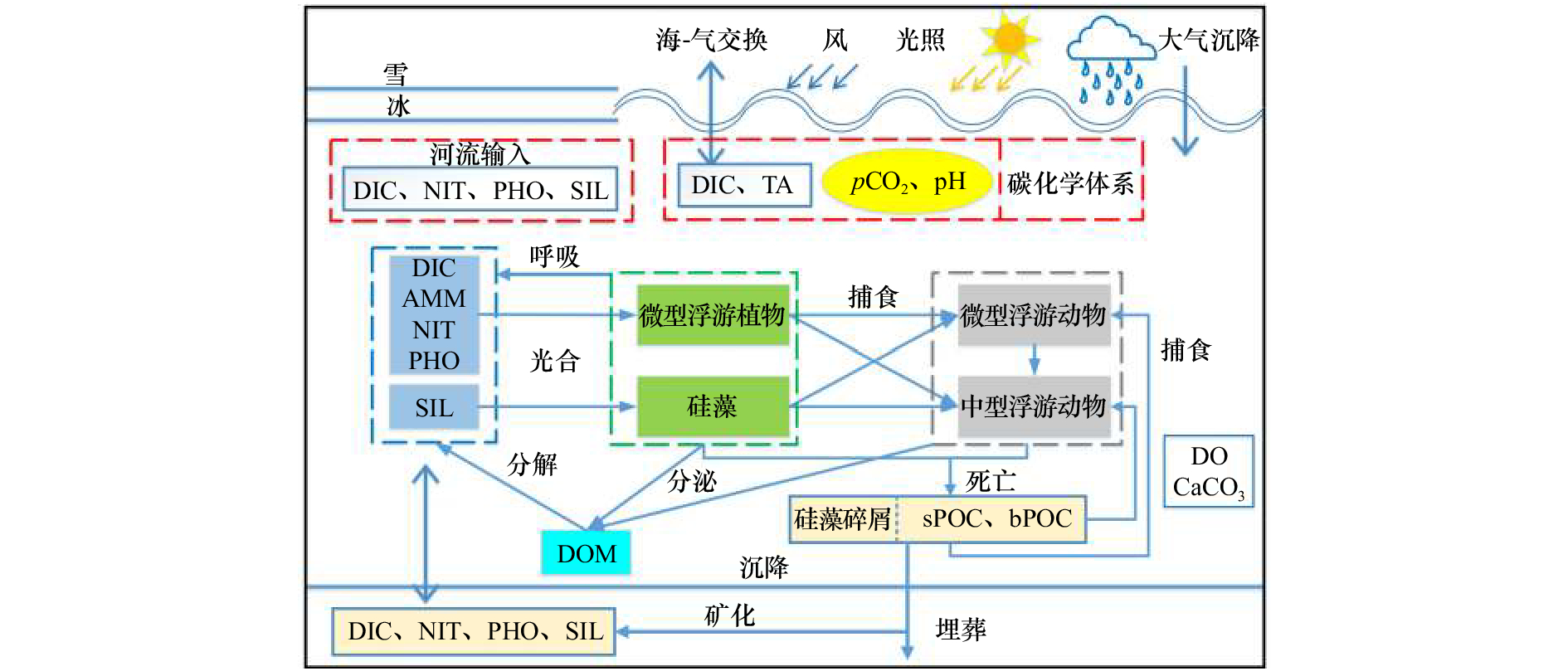
 下载:
下载:
